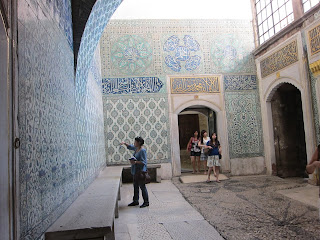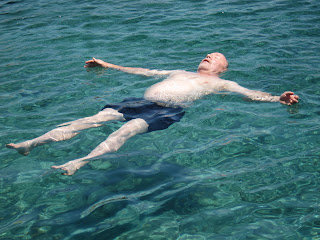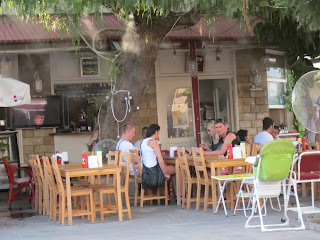We flew by Middle Eastern Airlines as both the service & food were preferable over our previous experience with Turkish Airlines - but missed out on our Star Alliance points. The flight was therefore from Jeddah to Istanbul via Beirut. Arriving required payment of our visitors visa at the airport, not understanding why Canadians were to pay twice the price of most other nationalities - maybe a previous political spat as had occured more recently with Dubai?
Our brief summer trip was to be to Turkey, a land that lies at the crossroads of Europe & Asia. Although a Muslim country it is a secular state, being fairly liberal in its outlook.
Istanbul, previously known for centuries as Constantinople, is a city of about 15 million people, nearly half the population of Canada. It is the only city to bridge two continents, Europe on the "old town" side, and Asia across the bridge that crosses the Bosphorus to the "new town". We were to stay in a hotel in the old town, hence in Europe.
As the title to this Blog suggests Istanbul is a fascinating city rich in history and culture.
Although originally settled by Greeks it became the capital of the Roman Empire (when the emperor Constantine named the city Constantinople), subsequently Byzantine (which was Christian with more Greek than Latin roots), then had its time with the Crusaders. During the middle ages it was the wealthiest and largest city in Europe. Eventually through more wars it became the seat of the Ottoman Empire (Muslim). Today it is a modern city showing evidence from all these various eras.
Culturally it bears influences of both the eastern Mediterranean and the Middle East.
Here is represented a superstition common in the Eastern Mediterranean & Middle East.
The "Evil Eye" is a look that is believed by many cultures to be able to cause harm or bad luck to the person it is directed against. These superstitions apparently are alluded to in the Old Testament.
Hence the development of charms or amulets, such as this one attached to the sidewalk in front of a store, to ward off the "evil eye". We saw many of these during our visit, and of course had to purchase our own.
Some of the walls from the "old town" (Constantinople) are still standing, fortunately protected to some degree from the forces inherent in building a modern city.
Being in the old town, aside from the main streets, there were many smaller side streets, this one with a view to the sea of Marmara. This body of water connects (via the Staits of Bosphorus) the Aegean to the South (the Med) to the Black Sea to the North. Clearly this was a city to be walked, and did we walk!
The streetscape was interesting, here this man enjoying his Turkish coffee.
As can be seen by my hand when ordering Turkish Coffee the cups & portions are small! About a third of the cup turns out to be semi solid - not for everyone although I enjoyed it. Curiously it is very common to get Nescafe (instant), although there are also a number of chains such as Starbucks available.
In addition there were many many stores selling various "sweets", many with a honey component (as you see in Greek deserts), although a number of them unique such as their "Turkish delight".
And of course in the old town there are many street and off the street restaurants. Note the Sisha apparatus on the table (on the right of the picture).
At this restaurant we witness a Dervish dance show. These men continue spinning for some time then amazingly can stop and look quite normal (not dizzy).
Not sure why he is dressed like this, although he seemed to enjoy the attention he received.
An open air street market.
A collection of colouful small homes on one of the side streets.
Approaching the entrance to the Grand Bazaar - the "invitations" to look were numerous.
The entrance to the Grand Bazaar, an integral part of strolling the old town. This has slowly grown over the last couple of centuries.
There were many "avenues" to explore in the labyrinth, again with many "invitations" to look.
Of course there were places to rest, have a coffee & a bite to eat - and imagine the past.
How can one come to this part of the world and not look at oriental rugs - the offer of coffee or tea while you look & talk about the wares available.
After the Grand Bazaar, it is time to explore the historical part of the old town.
There are two obelisks here from the ancient world - the nearest of Egyption origin, built in the 15th century BC (now about 3500 years old) - standing in Istanbul for 1600 years despite all the earthquakes, the one behind under repair of Greek origin, built 479 BC in Dephi, but brought to Istanbul in 326AD.
If one examines this part of the obelisk from Egypt an "evil eye" symbol stares at you from antiquity.
The entrance to Topkapi Palace, one of the most frequently visited museums in Europe. It was the residence and seat of government for the Ottoman Sultans for over 400 years. In addition to its interesting features, it contained the Imperial Treasury with its jewels (used for the Hollywood movie "Topkapi" where they try to steal some jewels), as well as the sword & cloak of the Prophet Mohammed. The Palace was surrounded with a 5 kilometre long wall, had 300 rooms, and apparently was self sufficient with many of the amenities of a small city.
The many coloured enameled tiles on the walls.
Further details of the walls.
One of the bedrooms - a high canopy.
A mock up of the Queen mother and her attendents. Apparently after the Sultan, in order of importance was the Queen Mother, then the Black Eunuch.
Part of the "Harem" section of the palace. Concubines and Eunuchs lived in these apartments. One Sultan apparently had about 1500 concubines during his tenure - hard to imagine! The origin of the Turkish word "harem" had its origins from the Arabic word "haram" meaning "forbidden".
Some of the views from the palace windows took in the "Golden Horn" and the "Bosphorus".
Another view from the palace, overlooking the Bosphorus - the "new town" in Asia (connected by bridges) is seen on the other side.
Lest we forget, there was also the Imperial Treasury. Unfortunately this is all I have as pictures were "haram" - the guard did yell at me when she saw me taking this one - at least she allowed me to keep my camera. A "small" piece of jewellery with the "mucho carat" emerald in the centre.
Time to leave the Palace to visit two of the iconic landmarks of Istanbul.
The "Hagia Sophia" in the distance. This was considered the greatest and most sacred piece of the city during the Byzantine period. It was built in 537AD initially as a church, and used as a church for over 900 years, then subsequently changed to a Mosque by the Ottomans, now a museum.
By comparison, the "Blue Mosque" (Sultan Ahmet Mosque) is the greatest and most splendid Mosque in Istanbul, its construction being completed in 1616. Although other mosques were built during the time of the Ottomans this was the last impressive structure of Ottoman religious architecture. It is the only mosque in Turkey with six minarets.
The interior of the "Blue Mosque", named for the many blues used in the interior tiles. The wall to wall oriental carpet is for praying on.The dome of the Mosque in the lower picture.
Evening has come - Ramadan has just started, hence the greetings for the event in Turkish.
Back on the streets for our walk back to the hotel - the city comes alive at night.
Time has come to say good night to Istanbul so that in the morning we can fly out to the small city of Bodrum on the south west corner of Turkey on the Aegean Sea coast - another experience with the Mediterranean shore.
On this "map" Bodrum is situated as a red dot on the shore (on a peninsula) close to the middle of the map. The island of Rhodes belonging to Greece sits just south east of it. The island of Kos, also Greek where Hippocrates was born, sits also just offshore.
Bodrum is an ancient town, initially settled about 1000 BC. It has some interesting historical features but today is a major tourist destination for those seeking sun & sea.
There is not much left of the ancient city walls. This was one of the entrances to the city.
This portrays images of the Seven Wonders of the Ancient World - the Mausoleum (Tomb) of Halicarnassus (modern Bodrum) is depicted as one of them. It was completed in 340 BC. Like that poem "Ozymandius" nothing much remains -----------
The remnants of the this gigantic tomb - this was destroyed in an earthquake.
As we spend our days walking extensively we start with a good breakfast. We managed to find a nice boutique hotel on Expedia located in the old town (within the old city walls) to start our morning journeys from. We got used to picking out olives, cucumber, tomatoes, cheese & bread, as well as the usual eggs, fruit & yogurt that we are used to at home. The Mediterranean twist was interesting. This was our usual morning table - a nice start to the day.
Along the outer walls of the hotel there was some intereting vegetation. Aside from the usual pine trees and palm trees, there were also examples of lime trees (closest on right) and banana trees (centre right). On the low lying bushes on the left there were also some chili bushes.
And a place to relax our weary feet - along with a gin & tonic!
Our morning walks, going toward the harbor region, pass through the narrow streets of the old town,
We pass the usual "white" houses seen in the Med (to reflect the hot sun), mixed in with old stone walls................................
......................................and narrow roads & lanes, not knowing where they go.
............ arriving by contrast to the "modern" part of the Bodrum Marina area, with its name brand shops and a different clientele. The sun & sea draw caters to a wide variety of folks.
At first a disappointment as the boats are near, but locked behind a fence - but this Marina is only a sample of the variety of harborside experiences to be found here. The boats at this location are the usual fibreglass models seen in many places, nothing really unique.
A little further along things become more interesting, as we approach the older established harbor region. This Crusader Castle dominates the Bodrum waterfront and puts a spell in the air. This waterfront has seen comings and goings for over two thousand years.
This is more a people harbor - some small boats, but ..........................................,,,,,,,,,,,,,,,,,,,,,,
.............. also many large boats, which would not fit anywhere in our home port of Bayfield. These boats are Gulets, traditionally designed two masted wooden sailing vessels. Bodrum is a major site for building these gulets. Many beautiful examples were seen .... these ones probably start at about 3 million Euros!! In addition just imagine the maintenance and crew bills? We talked our way on board a couple of them - woodwork and detailing simply amazing.
.......................................well the skipper can pretend. Maybe as crew to clean the decks.
Instead we talked to the skipper/owner of this modest vessel for a day on the water. He was running day charters - so it was to be two other families and us.
So off we went - the "skipper" (myself) on the left, another Canadian expat (lived in Dubai for 10 years) who also has a small sailboat, and the real skipper on the right. Our trip was under "iron jib" (diesel) but great to be out on the water.
The "Admiral" enjoying the view. "Burnt" hillsides from the hot summer sun - little to no rain in the summer with temperatures in the low - mid 30's C.
We manage to find some nice bays to anchor in to go for a dip.
.............................................the water is beautiful and quite buoyant.
...........................................a "small" gulet anchors next to us. Are they having more fun? Again a beautiful boat - but look at all that varnish to look after.
....................After a couple of bays with swimming, we anchor for lunch. We are cooked fresh fish (Bream), salad and pasta, with a glass of cool white wine to wash it down. Life is hard at this point.
.........................................Another hard day on the water. The shade is welcome.
..................... .Time to return. The views are very peaceful. It always amazes me how clear and blue the Med can be despite being almost a landlocked body of water surrounded by millions of people.
.......................................a Med look with the white houses in the background.
Back on shore we wander the waterfront and alleys close by. Note the large fans (right) that many of these restaurants have, many of them also blowing a cool mist of water - welcome in the heat.
Some of the establishments along the waterfront are familiar, being universal labels.
There are many interesting diversions and places to eat & drink in the harbor area.
As evening approaches a different atmosphere appears - eating out late is common, often with the whole family.
Evening descends with its soft light - the dockside is curved, seeing Bodrum Castle at the other end of the curve along the harborfront. Many restaurants, bars, & merchants line the whole edge of the waterfront as well as many of the backstreets closeby. Tomorrow is another adventure.
Our morning ritual after breakfast is to walk through the streets of the old town, down the hill, then along the harborfront. We look for another coffee on route.
As can be seen it is hilly country on the coast - hence walking down hill toward the harbor in the morning when it is cooler, then a taxi back at the end of the day when it is hot.....and feet tired.
Bodrum Castle is a remarkably intact Crusaders castle, built by the Knights of Rhodes in 1402. It was taken by the Turks (Ottomans) just over a hundred years later. Today it is a symbol of the city and houses a wonderful underwater archaelogical museum.
The castle has a number of passageways and stairs. Surprisingly the stairs are relatively steep..yes, more stairs
More stairs. The castle walls are actually quite steep.
A view out to sea from a lower set of battlements.
The Sphinx is a mythical creature which in Greek culture gave its victims a tragic death if unable to solve its riddle. One of the best known riddles is: "Which creature in the morning goes on four legs, at mid-day on two, and in the evening on three, the more legs it has the weaker it be?"
The Answer?
...................?
Man
............................................Did he pass or not?
The view from the top of the castle, looking into the next bay over from the harbor. Bodrum actually comprises of several bays on the peninsula. This bay has a thin beachfront, but lined with restaurants, merchants, and clubs.
Same bay looking closer to the sea, the town lining the seafront in the background.
As mentioned the castle contains an underwater archeological museum - that is items discovered from the seabed. This is an Amphora, made to carry wine or olive oil.
Large numbers of recovered amphorae, from the BC era. Any wine left?
As can be seen from a copy of an old print wine had the same effects on the ancients .
An anchor from a Roman ship, about 100 AD .
Stroll along the battlements before heading down. As noted a very well preserved castle.
There are many choices along the harbor area to have lunch.
Does she look surprised or hungry after all that walking? A Turkish lunch with grilled chicken & lamb, a Med style salad and chips. Some pita bread and humus goes well with it as well.
That evening out for a stroll. The city comes alive at night, when it cools down some, with much activity within a couple of blocks from the waterfront. The population is a mix of young, families, and some older folks.
We find a restaurant/bar with live music on the waterfront. As you can see there is a rim of activity stretching along the edge of the sea. Lights of the town can be seen going up the hillside.
She is singing in Turkish with a three person band. The music has an Arabic influence - an interesting experience. Other establishments were playing conventional music that we are used to at home.
Night has come and the sea is calm. It is time my friends to head back.






















































































No comments:
Post a Comment